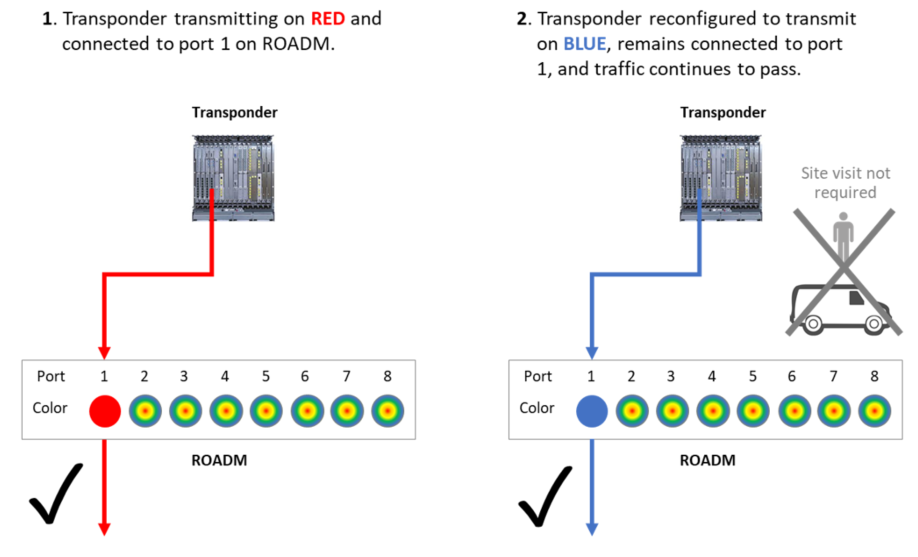The ROADM Tutorial Blogs, part 2

In this series of tutorials, I explain the key functionality (and their benefits) that underpin next-generation ROADMs: Colorless, Directionless, Contentionless, and Gridless (CDC-G) functionality.
In this blog, I explain the “C” in CDC-G – Colorless – and the operational benefits it provides.
Before Colorless – the limitations of previous ROADMs
Original ROADM technology dedicated a separate port for each wavelength. Usually ROADMs allocated the optical C-Band into 96 distinct channels, each carrying a different wavelength. We refer to these wavelengths as “colors”.
In this fixed environment, each of the 96 ports on the ROADM has a 1:1 mapping with the 96 colors. This is illustrated below (simplified to 8 colors representing 8 ports).

A transponder transmitting a red wavelength must be connected to the ROADM’s red port (#1). This fixed mapping is cumbersome for the following reasons:
- It requires clear instructions during installation to avoid misconnections – and assumes “as-built” records are up-to-date and correct
- It requires physical intervention for any configuration change
- Physical change requirements prevent network automation
Now, what happens when the service provider rearranges wavelengths and changes the wavelength of the transponder signal?
Changing wavelengths with Full-Band Tunable Lasers (FBTL)
With the introduction of transponders equipped with FTBLs, service providers could remotely reconfigure the transponder wavelength via software. There was no longer a need to physically change the optics. This is was a great convenience!
But once the wavelength changed, the transponder was no longer connected to the correct ROADM port, and traffic was blocked, because of the 1:1 port/color mapping. The service provider had to send a technician on-site to physically reconnect the fiber cable to the correct port in order to restore signal flow.
This was time consuming. It required planning, site access coordination as well as drive time to visit two sites (both ends of the circuit). Changing the color of a wavelength still could not be fully automated due to the need for site visits.

The Convenience and Flexibility of Colorless Ports
Colorless ROADMs eliminate the 1:1 mapping between the physical port and the wavelength color. Any port can now accommodate any color:

One can almost view the ROADM port as a chameleon. The port no longer has a specific color, it can assume any color it is requested to.
With this colorless functionality, any transponder wavelength can be connected to any ROADM port, and the wavelength can be recolored anytime. This is now a much easier, quicker, and more cost-effective operation, resulting in significant improvements:
- Simplified installation – any wavelength to any port
- Elimination of installation errors and possible downtime
- Elimination of site visits by field technicians
- Instantaneous and remote reconfiguration
- Enables network automation

“Colorless” functionality is supported on all 1FINITY Lambda series blades. This feature is one of the fundamental building blocks for automating the network, reducing operational expenses, reducing downtime, and ultimately increasing customer satisfaction.